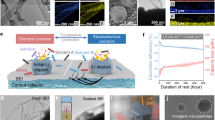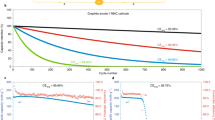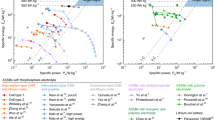Abstract
Accurate assessment of the reversibility of electrodes is crucial for battery performance evaluations. However, it is challenging to acquire the true reversibility of the Li anode in lithium-metal batteries, mainly because an excessive amount of Li is commonly used. Here we propose an analytic approach to quantitatively evaluate the reversibility of practical lithium-metal batteries. We identify key parameters that govern the anode reversibility and subsequently establish their relationship with the cycle number by considering the mass of active and inactive Li of the cycled Li anode. Using this method, we show that the mass of active Li can be quantitatively distinguished from the mass of inactive Li of the cycled anodes in Amp hour-level pouch cells. This work opens an avenue for accurately assessing degradation and failure in lithium-metal batteries.
This is a preview of subscription content, access via your institution
Access options
Access Nature and 54 other Nature Portfolio journals
Get Nature+, our best-value online-access subscription
$29.99 / 30 days
cancel any time
Subscribe to this journal
Receive 12 digital issues and online access to articles
$119.00 per year
only $9.92 per issue
Buy this article
- Purchase on Springer Link
- Instant access to full article PDF
Prices may be subject to local taxes which are calculated during checkout





Similar content being viewed by others
Data availability
The datasets analysed and generated during the current study are included in the paper and its Supplementary Information. Source data are provided with this paper.
References
Liu, J. et al. Pathways for practical high-energy long-cycling lithium metal batteries. Nat. Energy 4, 180–186 (2019).
Albertus, P., Babinec, S., Litzelman, S. & Newman, A. Status and challenges in enabling the lithium metal electrode for high-energy and low-cost rechargeable batteries. Nat. Energy 3, 16–21 (2017).
Chen, S. et al. Critical parameters for evaluating coin cells and pouch cells of rechargeable Li-metal batteries. Joule 3, 1094–1105 (2019).
Chen, S., Dai, F. & Cai, M. Opportunities and challenges of high-energy lithium metal batteries for electric vehicle applications. ACS Energy Lett. 5, 3140–3151 (2020).
Fang, C., Wang, X. & Meng, Y. S. Key issues hindering a practical lithium-metal anode. Trends Chem. 1, 152–158 (2019).
Zhang, X., Yang, Y. & Zhou, Z. Towards practical lithium-metal anodes. Chem. Soc. Rev. 49, 3040–3071 (2020).
Weber, R. et al. Long cycle life and dendrite-free lithium morphology in anode-free lithium pouch cells enabled by a dual-salt liquid electrolyte. Nat. Energy 4, 683–689 (2019).
Huang, C.-J. et al. Decoupling the origins of irreversible Coulombic efficiency in anode-free lithium metal batteries. Nat. Commun. 12, 1452 (2021).
Deng, W. et al. Competitive solvation-induced concurrent protection on the anode and cathode toward a 400 Wh kg−1 lithium metal battery. ACS Energy Lett. https://doi.org/10.1021/acsenergylett.0c02351 (2020).
Deng, W., Zhou, X., Fang, Q. & Liu, Z. Microscale lithium metal stored inside cellular graphene scaffold toward advanced metallic lithium anodes. Adv. Energy Mater. 8, 1703152 (2018).
Kim, M. S. et al. Langmuir–Blodgett artificial solid-electrolyte interphases for practical lithium metal batteries. Nat. Energy 3, 889–898 (2018).
Adams, B. D., Zheng, J., Ren, X., Xu, W. & Zhang, J. G. Accurate determination of Coulombic efficiency for lithium metal anodes and lithium metal batteries. Adv. Energy Mater. 8, 1702097 (2018).
Xiao, J. et al. Understanding and applying Coulombic efficiency in lithium metal batteries. Nat. Energy 5, 561–568 (2020).
Holtstiege, F., Wilken, A., Winter, M. & Placke, T. Running out of lithium? A route to differentiate between capacity losses and active lithium losses in lithium-ion batteries. Phys. Chem. Chem. Phys. 19, 25905–25918 (2017).
Niu, C. et al. Balancing interfacial reactions to achieve long cycle life in high-energy lithium metal batteries. Nat. Energy 6, 723–732 (2021).
Paul, P. P. et al. A review of existing and emerging methods for lithium detection and characterization in Li-ion and Li-metal batteries. Adv. Energy Mater. 11, 2100372 (2021).
Fang, C. et al. Quantifying inactive lithium in lithium metal batteries. Nature 572, 511–515 (2019).
Chen, K.-H. et al. Dead lithium: mass transport effects on voltage, capacity, and failure of lithium metal anodes. J. Mater. Chem. A 5, 11671–11681 (2017).
Lu, D. et al. Failure mechanism for fast‐charged lithium metal batteries with liquid electrolytes. Adv. Energy Mater. 5, 1400993 (2015).
Xu, S., Chen, K.-H., Dasgupta, N. P., Siegel, J. B. & Stefanopoulou, A. G. Evolution of dead lithium growth in lithium metal batteries: experimentally validated model of the apparent capacity loss. J. Electrochem. Soc. 166, A3456 (2019).
Chandrashekar, S. et al. 7Li MRI of Li batteries reveals location of microstructural lithium. Nat. Mater. 11, 311–315 (2012).
Gunnarsdóttir, A. B., Amanchukwu, C. V., Menkin, S. & Grey, C. P. Noninvasive in situ NMR study of ‘dead lithium’ formation and lithium corrosion in full-cell lithium metal batteries. J. Am. Chem. Soc. 142, 20814–20827 (2020).
Aryanfar, A., Brooks, D. J., Colussi, A. J. & Hoffmann, M. R. Quantifying the dependence of dead lithium losses on the cycling period in lithium metal batteries. Phys. Chem. Chem. Phys. 16, 24965–24970 (2014).
McShane, E. J. et al. Quantification of inactive lithium and solid–electrolyte interphase species on graphite electrodes after fast charging. ACS Energy Lett. 5, 2045–2051 (2020).
Janakiraman, U., Garrick, T. R. & Fortier, M. E. Lithium plating detection methods in Li-ion batteries. J. Electrochem. Soc. 167, 160552 (2020).
Hsieh, Y.-C. et al. Quantification of dead lithium via in situ nuclear magnetic resonance spectroscopy. Cell Rep. Phys. Sci. 1, 100139 (2020).
Gunnarsdóttir, A. B., Vema, S., Menkin, S., Marbella, L. E. & Grey, C. P. Investigating the effect of a fluoroethylene carbonate additive on lithium deposition and the solid electrolyte interphase in lithium metal batteries using in situ NMR spectroscopy. J. Mater. Chem. A 8, 14975–14992 (2020).
Xiang, Y. et al. Quantitatively analyzing the failure processes of rechargeable Li metal batteries. Sci. Adv. 7, eabj3423 (2021).
Fang, C. et al. Pressure-tailored lithium deposition and dissolution in lithium metal batteries. Nat. Energy 6, 987–994 (2021).
Bao, W. et al. Quantifying lithium loss in amorphous silicon thin-film anodes via titration-gas chromatography. Cell Rep. Phys. Sci. 2, 100597 (2021).
Zheng, J. et al. Physical orphaning versus chemical instability: is dendritic electrodeposition of Li fatal? ACS Energy Lett. 4, 1349–1355 (2019).
Niu, C. et al. High-energy lithium metal pouch cells with limited anode swelling and long stable cycles. Nat. Energy 4, 551–559 (2019).
Hu, Z. et al. Self-adaptive 3D skeleton with charge dissipation capability for practical Li metal pouch cells. Nano Energy 93, 106805 (2022).
Gao, N. et al. Fast diagnosis of failure mechanisms and lifetime prediction of Li metal batteries. Small Methods 5, 2000807 (2021).
Wood, K. N., Noked, M. & Dasgupta, N. P. Lithium metal anodes: toward an improved understanding of coupled morphological, electrochemical, and mechanical behavior. ACS Energy Lett. 2, 664–672 (2017).
Wang, L. et al. Identifying the components of the solid–electrolyte interphase in Li-ion batteries. Nat. Chem. 11, 789–796 (2019).
Nie, M. et al. Lithium ion battery graphite solid electrolyte interphase revealed by microscopy and spectroscopy. J. Phys. Chem. C. 117, 1257–1267 (2013).
Hirota, N. Electron paramagnetic resonance studies of ion pairs. Structures and equilibria in alkali metal naphthalenide and anthracenide. J. Am. Chem. Soc. 90, 3603–3611 (1968).
Zhang, X. et al. Rethinking how external pressure can suppress dendrites in lithium metal batteries. J. Electrochem. Soc. 166, A3639–A3652 (2019).
Yin, X. et al. Insights into morphological evolution and cycling behaviour of lithium metal anode under mechanical pressure. Nano Energy 50, 659–664 (2018).
Louli, A. J. et al. Exploring the impact of mechanical pressure on the performance of anode-free lithium metal cells. J. Electrochem. Soc. 166, A1291–A1299 (2019).
Monroe, C. & Newman, J. The impact of elastic deformation on deposition kinetics at lithium/polymer interfaces. J. Electrochem. Soc. https://doi.org/10.1149/1.1850854 (2005).
Wood, K. N. et al. Dendrites and pits: untangling the complex behavior of lithium metal anodes through operando video microscopy. ACS Cent. Sci. 2, 790–801 (2016).
Brissot, C., Rosso, M., Chazalviel, J.-N. & Lascaud, S. Dendritic growth mechanisms in lithium/polymer cells. J. Power Sources 81, 925–929 (1999).
Chen, X. R. et al. A diffusion‐reaction competition mechanism to tailor lithium deposition for lithium‐metal batteries. Angew. Chem. Int. Ed. 132, 7817–7821 (2020).
Bai, P., Li, J., Brushett, F. R. & Bazant, M. Z. Transition of lithium growth mechanisms in liquid electrolytes. Energy Environ. Sci. 9, 3221–3229 (2016).
Liu, Y. et al. Insight into the critical role of exchange current density on electrodeposition behavior of lithium metal. Adv. Sci. 8, 2003301 (2021).
Yamaki, J.-i et al. A consideration of the morphology of electrochemically deposited lithium in an organic electrolyte. J. Power Sources 74, 219–227 (1998).
Wang, S. H. et al. Stable Li metal anodes via regulating lithium plating/stripping in vertically aligned microchannels. Adv. Mater. 29, 1703729 (2017).
Liu, F. et al. Dynamic spatial progression of isolated lithium during battery operations. Nature 600, 659–663 (2021).
Acknowledgements
This work was supported by National Natural Science Foundation of China (grant number 52001320, 51872305), ‘Lingyan’ Research and Development Plan of Zhejiang Province (grant number 2022C01071) and China Postdoctoral Science Foundation funded project (grant number 2019TQ0331, 2019M662123). Y.S.M. acknowledges funding support from the Zable Endowed Chair of Energy Technology and the Sustainable Power & Energy Center of UC San Diego. W.D. thanks F. Zhao for helpful discussions about the work; Q. Guo for discussions about mathematical equations; Z. Jiang, Q Han, W. Fang and J. Wang for their help on the pouch cell assembly and tests; and A. Cao, Y. Yu, S. Liu and H. Li for their help on ICP-OES and GC characterizations. W.D. thanks Y. Han for help with GC analysis, Y. Li for Ar-BET characterizations and K. Shen for ICP-OES analysis from the testing centre of NIMTE, CAS.
Author information
Authors and Affiliations
Contributions
W.D., X.Z., Y.S.M. and Z.L. conceived the concept and the project. W.D. and W.B. performed the analytical procedures and data analysis. W.D. and X.Y. performed the ICP-OES characterizations. W.D., Z.H. and B.H. assembled and tested the pouch cells. W.D., W.B., X.Z., B.Q., Y.S.M. and Z.L. wrote and revised the manuscript. All authors discussed the results and reviewed the manuscript.
Corresponding authors
Ethics declarations
Competing interests
The authors declare no competing interests.
Peer review
Peer review information
Nature Energy thanks the anonymous reviewers for their contribution to the peer review of this work.
Additional information
Publisher’s note Springer Nature remains neutral with regard to jurisdictional claims in published maps and institutional affiliations.
Supplementary information
Supplementary Information
Supplementary Figs. 1–27, Discussion and Tables 1–12.
Source data
Source Data Fig. 4
Source data for Fig. 4.
Rights and permissions
Springer Nature or its licensor holds exclusive rights to this article under a publishing agreement with the author(s) or other rightsholder(s); author self-archiving of the accepted manuscript version of this article is solely governed by the terms of such publishing agreement and applicable law.
About this article
Cite this article
Deng, W., Yin, X., Bao, W. et al. Quantification of reversible and irreversible lithium in practical lithium-metal batteries. Nat Energy 7, 1031–1041 (2022). https://doi.org/10.1038/s41560-022-01120-8
Received:
Accepted:
Published:
Issue Date:
DOI: https://doi.org/10.1038/s41560-022-01120-8
This article is cited by
-
External-pressure–electrochemistry coupling in solid-state lithium metal batteries
Nature Reviews Materials (2024)
-
High lithium oxide prevalence in the lithium solid–electrolyte interphase for high Coulombic efficiency
Nature Energy (2024)
-
Tactics to optimize conversion-type metal fluoride/sulfide/oxide cathodes toward advanced lithium metal batteries
Nano Research (2023)
-
Lithium quantified, dead or alive
Nature Energy (2022)



